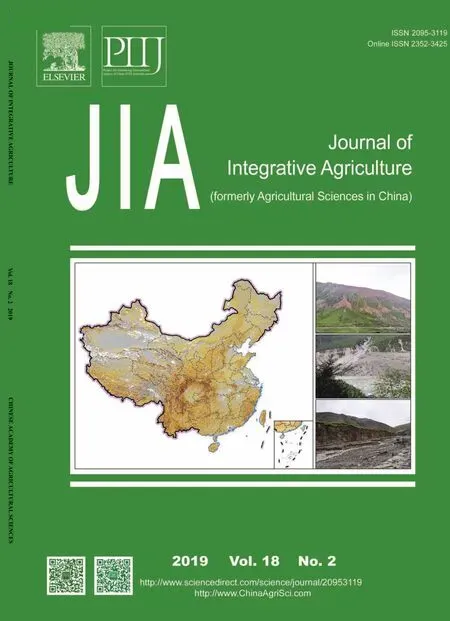Digital mapping in agriculture and environment
2019-03-05SHIZhou,ZHANGWei-li,TENGHong-fen
Global demand for soil data and information for maintaining and improving agricultural productivity and environmental health is soaring. The accurate and rapid digital maps of soil characteristics are of key importance for evaluation of soil fertility, precision management of crop inputs, estimation of carbon stocks, and modeling ecological responses as well as environmental threats.
The progress in digital soil mapping (DSM) over the last decade provided an improved choice to monitor and map soil characteristics in space and time. Previous reviews have discussed the history (McBratneyet al. 2003; Harteminket al. 2013; Minasny and McBratney 2016) and the progress in DSM in general (Grunwaldet al. 2011; Zhanget al. 2017). However, the field of DSM has been moving at an accelerated pace and the progress has been observed in all aspects including data organization and quality, soil sampling, environmental covariates, predictive models, and map validation. In this special issue, the selected eight papers document some of the scopes, developments and progresses in digital mapping in agriculture and environment.
First four papers documented the progress and developments in predictive models. Tenget al. (2019) used new methodologies including Collocated CoKriging (ColCOK),geographically weighted regression (GWR) and Random Forest (RF) regression to integrate satellite images, field samples, and ground observations to map the soil loss potential in China. Chenget al. (2019) proposed a method of mining soil–environmental relationships from individual soil polygons to update conventional soil maps of the Raffelson watershed in La Crosse County, Wisconsin, United States.Gaoet al. (2019) predicted the spatial variability of soil total nitrogen (TN), total phosphorus (TP) and total potassium(TK) using geostatistical analysis and regression analysis.Liet al. (2019) evaluated the spatial variability of soil bulk density and its controlling factors at different soil layers in Southwest China’s agricultural intensive area.
The following three papers documented the progress in environmental covariate selection, processing and utilization. Luet al. (2019) proposed a framework integrating Pearson correlation analysis, generalized additive models(GAMs), and Random Forest (RF) to select environmental covariates for predictive soil depth mapping in the upper reaches of the Heihe River Basin in Northwest China. Wuet al. (2019) used the combination of surface albedo computed from moderate resolution imaging spectroradiometer(MODIS) re flectance products and the actual measured soil moisture data to map an albedo/vegetation coverage trapezoid feature space. Wanget al. (2019) applied natural language processing (NLP) and rule-based techniques to automatically extract and structure information from soil survey reports regarding soil–environment relationships.
The last paper talked about soil sampling. Guoet al.(2019) employed EM38 data to estimate the spatio-temporal variation of soil salinity in different site-specific management zones. Fuzzy-kmeans algorithm was used to divide the site-specific management zones and to help sampling design.
We believe that the reader both in China and abroad will be interested in these articles and be inspired with the finding of the papers for developing future research on digital mapping in agriculture and environment. We want to express our deepest appreciation to all the authors for their high-quality contributions and efforts to make this special issue a great success.
SHI Zhou Guest Editor College of Environmental and Resource Sciences,
Zhejiang University,Hangzhou 310058, P.R.China
ZHANG Wei-li Executive Editor-in-Chief Institute of Agricultural Resources and Regional Planning,
Chinese Academy of Agricultural Sciences,Beijing 100081, P.R.China
TENG Hong-fen
Guest Editor College of Environmental and Resource Sciences,
Zhejiang University,Hangzhou 310058, P.R.China
杂志排行
Journal of Integrative Agriculture的其它文章
- Maize production under risk: The simultaneous adoption of off-farm income diversification and agricultural credit to manage risk
- miR-34c inhibits proliferation and enhances apoptosis in immature porcine Sertoli cells by targeting the SMAD7 gene
- lnhibition of KU70 and KU80 by CRlSPR interference, not NgAgo interference, increases the ef ficiency of homologous recombination in pig fetal fibroblasts
- Protective roles of trehalose in Pleurotus pulmonarius during heat stress response
- Kiwifruit (Actinidia chinensis) R1R2R3-MYB transcription factor AcMYB3R enhances drought and salinity tolerance in Arabidopsis thaliana
- Arbuscular mycorrhizal fungi combined with exogenous calcium improves the growth of peanut (Arachis hypogaea L.) seedlings under continuous cropping
